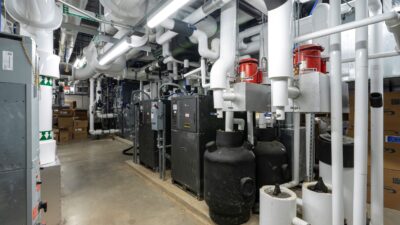Damage caused from an accidental discharge in one of these occupancies can be costly, easily reaching into the millions. These costs are related to damage to aircraft, foam resupply, removal of contaminant, cleanup and manpower, and the potential loss of future business.

Learning Objectives:
- Understand the applications of an NFPA 11 system.
- Understand the relation of NFPA 11 systems to aircraft hangars.
- Apply acceptance-testing requirements to ensure system reliability.
Low-expansion foam systems are commonly used to protect outdoor storage tanks, interior flammable liquid hazards, loading racks, and diked or undiked spill areas. Medium- or high- expansion foam systems are more suited to the protection of ordinary combustibles and flammable and combustible liquids. Liquefied natural gas operations can be only adequately protected by high-expansion systems. NFPA 11: Standard for Low-, Medium-, and High-Expansion Foam outlines the design, installation, and maintenance requirements for these systems.
A common use for these foam systems is in aircraft hangars. Out of the four aircraft hangar groups defined in NFPA 409: Standard on Aircraft Hangars, three of them require foam systems to be designed, installed, and maintained in accordance with NFPA 11. Hangar groups I and II require low-level, low-expansion and low-level high-expansion systems to meet the standard. Group IV aircraft hangars having a fire area larger than 12,000 sq ft, housing fueled aircraft, must have foam systems installed to this standard, as well.
Damage caused from an accidental discharge in one of these occupancies can be costly, easily reaching into the millions. These costs are related to damage to aircraft, foam resupply, removal of contaminant, cleanup and manpower, and the potential loss of future business. Ensuring reliability of these systems, and preventing unintentional discharges, starts when the system is first installed.
To protect the operational integrity of these systems, the acceptance-testing procedures outlined in NFPA 11 must be closely followed, with no steps missed. Chapter 11 of NFPA 11 provides the following guidance for acceptance testing.
- Flush water supply mains prior to connection to system piping.
- Hydrostatically test all system piping at 200 psi for 2 hours.
- Functionally test all operational devices and equipment, to include:
- Integrated systems
- Automatic closet devices for doors, windows, and conveyors
- Automatic equipment interlocks
- Automatically opening heat and smoke vents
- Electrical control circuits and supervisory systems (confirm system must be able to function in the event of power outage).
- Test the adequacy of the water supply. Open the main drain and allow water to flow until system pressure stabilizes.
- Test all control valves by turning to the fully opened and fully closed position while under pressure.
- Conduct a discharge, full-flow test to ensure the hazard area is fully protected.
- Flush all system piping.
- Complete material and test certificates.
- Ensure reserve foam concentrate is supplied.
Aircraft hangars require a reserve foam concentrate supply in a quantity that meets the design requirements to put the system back into service after operation. Previous editions of NFPA 409 required a connected foam reserve. The most current edition allows the reserves to meet the same reserve requirements of NFPA 11, which only requires that the reserve supply is either stored onsite or can be obtained within 24 hours to put the system back into service.
Following the testing procedures of NFPA 11, in conjunction with a commissioning and integrated system testing plan, will ensure the reliability and longevity of these systems.
-Aaron Johnson is a fire marshal and a fire strategist, trainer, and author at https://thecodecoach.com. He has more than a decade of fire protection/life safety experience and is a leading authority on fire protection and life safety for aviation and industrial facilities.
Download a printable NFPA 11 acceptance testing checklist.
Definitions:
low-level system: fire protection applications that provide coverage below large obstructions (i.e., airplane wings)
low-expansion foam: foam having an expansion ratio between 2:1 and 20:1
medium-expansion foam: foam having an expansion ratio between 20:1 and 200:1
high-expansion foam: foam having an expansion ratio above 200:1



